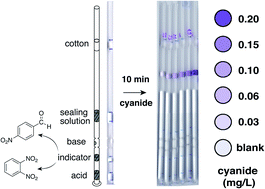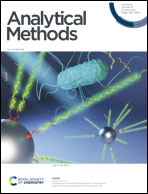A membraneless gas-trapping device for cyanide detection and quantification†
Abstract
A novel device for trapping gaseous compounds was invented and employed to create a user-friendly cyanide test kit for aqueous solutions. This specially designed device is housed in a small polypropylene straw with one end sealed. The device is packaged with chemicals to liberate, trap and quantify hydrogen cyanide gas. Piercing a pinhole near the bottom of the device and lowering it into the sample allows the sample to enter the device. When a sufficient amount of sample has entered the device, the device is sealed by wetting of cotton with propylene glycol inside the device. The hydrogen cyanide gas is generated by reacting the sample with sulfuric acid inside the device. The produced hydrogen cyanide is trapped by potassium hydroxide, and it is detected by the reaction between p-nitrobenzaldehyde and o-dinitrobenzene, using cyanide ions as a catalyst, to produce a purple compound of o-nitrophenyl hydroxylamine dianions. Within 10 minutes, this method provides a linear working range of 0.02–0.20 mg L−1 CN−. The calibration line has a coefficient of determination of 0.99. Moreover, this device does not require any addition of chemicals by users, thus increasing its safety and ease of use. The developed device was applied to measure the concentration of cyanide in natural water, fresh bamboo shoots, and fruit juice.



 Please wait while we load your content...
Please wait while we load your content...